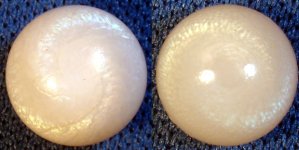SteveM
Well-known member
- Joined
- Jan 29, 2007
- Messages
- 2,117
Alien eyeball?
OK, one image too many! I promise to post no more of this particular pearl until a proper camera and/or photographer can be employed! The pearl is endlessly fascinating with its inner light and surface patterns, well beyond my ability to capture.
But GemGeek's comment serves as a useful reminder that this is anything but a beauty contest. Reliable ID for Nautilus pearls is the issue, as no specimen to date, certified or otherwise?with the potential exception of this pearl (all cat-ting aside!)?offers anything other than anecdotal support.


